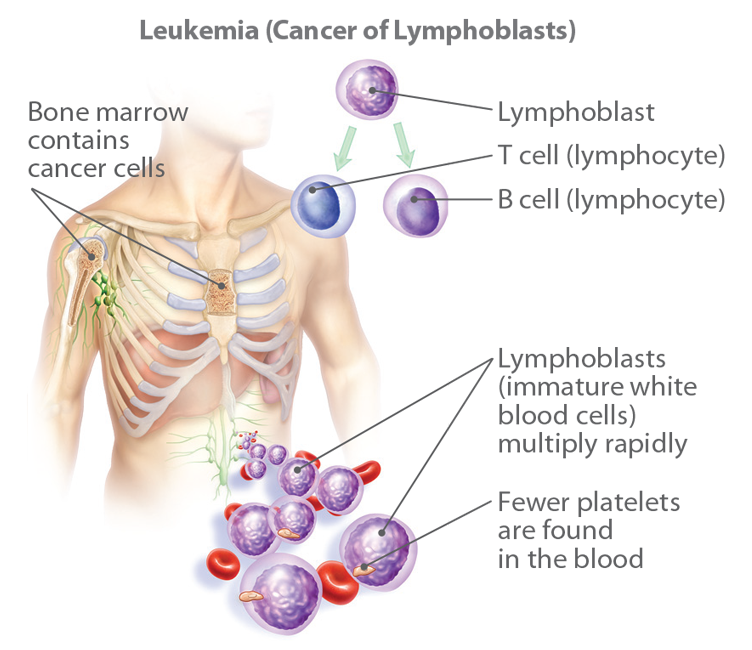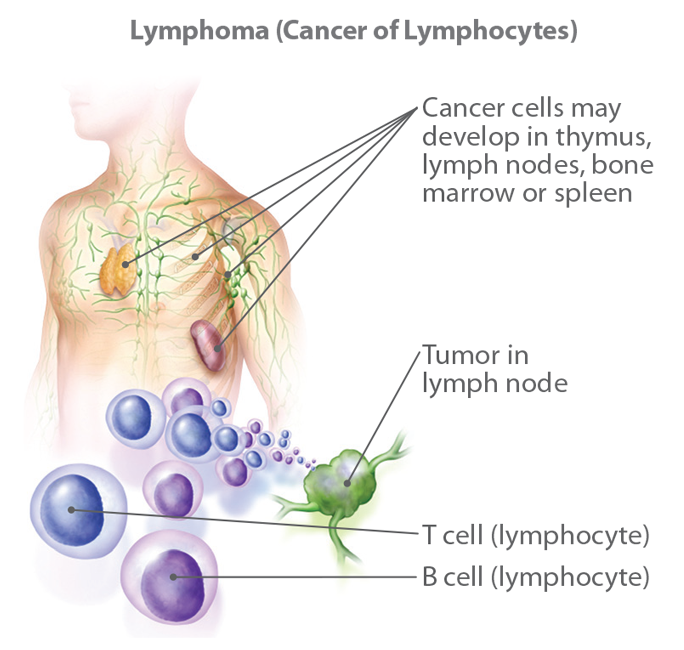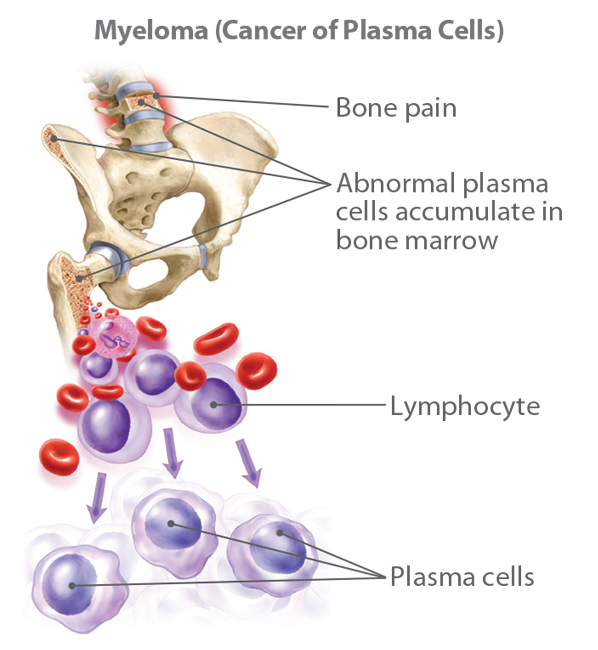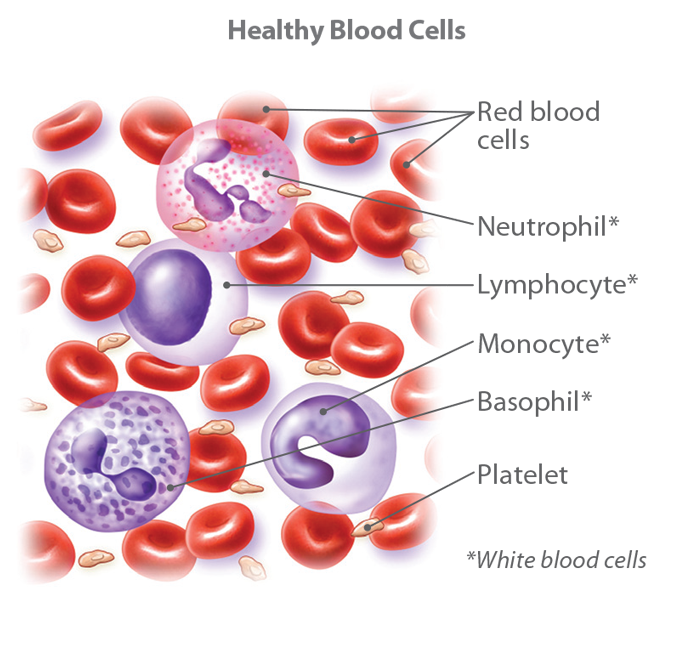Understanding blood cancer
Most blood cancers start in the bone marrow (the soft, inner part of some bones), where the body produces red blood cells, white blood cells and platelets. When cancer causes the uncontrolled growth of abnormal blood cells, it interferes with the blood’s ability to perform vital functions such as carrying nutrients, fighting infections and clotting. There are three main types of blood cancers:
Leukemia is cancer that originates in blood cells or bone marrow. In most cases, leukemia forms in white blood cells, which help the body fight infections. When leukemia cells grow out of control, they crowd out healthy cells, making it difficult for the body to control bleeding and fight infections.
Lymphoma is cancer that develops from cells in the lymphatic system (part of the body’s immune system) called lymphocytes. Lymphomas are divided into two categories, based on examination of the cancer cells:
- Hodgkin lymphoma is marked by the presence of an abnormal lymphocyte called the Reed-Sternberg cell.
- Non-Hodgkin lymphoma (also called non-Hodgkin’s lymphoma or NHL) is more common and includes more than 30 distinct types, which can be divided into aggressive (fast-growing or high grade) or indolent (slow growing or low grade). NHL can develop in many parts of the body, including the lymph nodes and spleen.
Multiple myeloma (also called Kahler disease or plasma cell myeloma) causes the body to produce an abundance of abnormal plasma cells that form tumors in the bone marrow. The tumors overcrowd the bone marrow and prevent the normal reproduction of healthy blood cells.
Stages of blood cancer
The stage of blood cancer is one of the most important factors in evaluating your treatment options. Our cancer doctors use a variety of diagnostic tests to evaluate blood cancer and develop the appropriate treatment plan for you.
Leukemia: Most cancers are staged based on the size and spread of tumors. However, because leukemia already occurs in the developing blood cells in the bone marrow, leukemia staging is a little bit different. The stages of leukemia are often characterized by blood cell counts and the accumulation of leukemia cells in other organs, like the liver or spleen. Making an educated treatment decision begins with the stage, or progression, of the disease. Factors affecting leukemia staging and prognosis include:
- White blood cell or platelet count
- Age (advanced age may negatively affect prognosis)
- History of prior blood disorders
- Chromosome mutations or abnormalities
- Bone damage
- Enlarged liver or spleen
For more detailed information about staging specific types of leukemia (ALL, AML, CLL and CML), please see leukemia staging and grading.
Hodgkin lymphoma: The stages—1, 2, 3 and 4—are determined by how much the disease has spread from a single lymph node region to the rest of the body. The stages of Hodgkin lymphoma are:
- Stage 1 (stage 1 Hodgkin lymphoma): The cancer has only affected one lymph node region or organ.
- Stage 2 (stage 2 Hodgkin lymphoma): Two or more lymph nodes are affected. The cancer is either above or below the diaphragm.
- Stage 3 (stage 3 Hodgkin lymphoma): The cancer may affect lymph nodes on both sides of the diaphragm.
- Stage 4 (stage 4 Hodgkin lymphoma): Cancer cells have moved beyond the lymph system into other tissues and organs, such as the liver, lungs or bones.
Non-Hodgkin lymphoma: Stages are identified using numbers 1 through 4. Doctors may also use the letters A, B, E and S to help describe the cancer:
- A and B: The letter B indicates the presence of one or more of the following symptoms: drenching night sweats, fever or unexplained weight loss. The letter A is used if there is no evidence of B symptoms.
- E and S: The letter E indicates the disease affects tissues or organs outside the lymphatic system. The letter S is used if the disease has spread to the spleen.
- X: If the disease is considered bulky (greater than 10 cm in size), it is designated with an X.
The stages of non-Hodgkin lymphoma are:
- Stage 1 (stage 1 non-Hodgkin lymphoma): The cancer is found in a single region or organ, usually one lymph node and the surrounding area.
- Stage 2 (stage 2 non-Hodgkin lymphoma): The cancer is found in two or more lymph node regions on the same side of the diaphragm, either above or below it.
- Stage 3 (stage 3 non-Hodgkin lymphoma): The cancer is found in lymph nodes on both sides of the diaphragm.
- Stage 4 (stage 4 non-Hodgkin lymphoma): The cancer has spread to one or more tissues or organs outside the lymph system, such as the liver, lungs or bones, and may be found in lymph nodes near or far away from those organs.
Multiple myeloma: Stages are determined in the following ways:
- Stage 0: Smoldering myeloma (also called asymptomatic myeloma), a slow-growing type of multiple myeloma, is characterized by increased plasma cells in the bone marrow and the presence of monoclonal proteins, without the presence of symptoms. Smoldering myeloma typically uses a "watch and wait" approach, which holds off on treatment until the disease progresses, with close monitoring of diagnostic tests.
- Stage 1 (stage 1 multiple myeloma): Tests indicate there are a relatively small number of myeloma cells. The levels of beta-2 microglobulin may be slightly higher than normal and the levels of albumin (a water soluble protein) may have decreased.
- Stage 2 (stage 2 multiple myeloma): This is an intermediate stage assigned if the levels tested fall between the standards set for stage 1 and stage 3.
- Stage 3 (stage 3 multiple myeloma): In this stage, the number of myeloma cells is considered high. The most advanced stage of multiple myeloma is characterized by high levels of beta-2 microglobulin and low levels of albumin.



